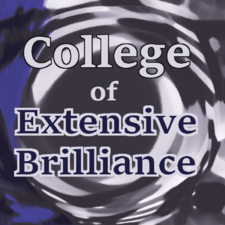College of Extensive Brilliance
College of Extensive Brilliance
51 5th Street, Hendrix
Industry: Education
Entity type: Non-profit, public
Product: Secondary education
Specialties: Omnicultural studies, neurotheology, climatic and meteorological sciences
Enrollment: 30,300
Revenue (CRRS): K
Colors: Bunting Blue, Alto Lavender
The College of Extensive Brilliance (CEB) is a public institution of secondary education located in Hendrix. CEB is a popular destination for higher education among primary graduates of the region thanks to the college's well-regarded academic programs omnicultural studies, neurotheology, and the climatic and meteorological sciences.
The student body at the College of Extensive Brilliance, totaling 30,300 students, heavily represents natives of western costal Illuminatia. Students from the West Coast Megalopolitan Complex frequently seek the CEB for their secondary educational needs.
CEB receives funding from the Bureau of Education and Enlightenment (BEE) and oversight from the BEE's Office of Curriculum and Programming (OCP). As with most public educational institutions, public funding accounts for nearly all of CEB's budget, which averages 3,336,000μ/AU.
As with all public education institutions, students of the College of Extensive Brilliance benefit from a nearly 100% placement rate upon graduation thanks the Occupational and Instructional Productivity and Placement System (OIPPS), a government-assisted career matching program administered by the BEE's Office of Assessment and Placement (OAP). The OIPPS matches graduates with further educational programs, research assignments, or employment, based upon the student's interests and talents.
Students from the CEB's Omnicultural Studies department are known to make it their unofficial and clandestine project throughout the academic year to concoct a new thought tradition, with well-thought rituals, rites of passage, and belief systems. Students at the beginning of the following year then make this thought tradition popular among the student body, leading to much of the college's students becoming devout followers of the invented thought tradition.
